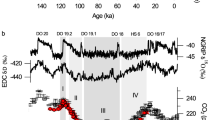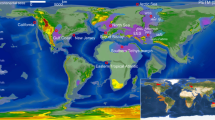Abstract
The transient global warming event known as the Palaeocene–Eocene Thermal Maximum occurred about 55.9 Myr ago. The warming was accompanied by a rapid shift in the isotopic signature of sedimentary carbonates, suggesting that the event was triggered by a massive release of carbon to the ocean–atmosphere system. However, the source, rate of emission and total amount of carbon involved remain poorly constrained. Here we use an expanded marine sedimentary section from Spitsbergen to reconstruct the carbon isotope excursion as recorded in marine organic matter. We find that the total magnitude of the carbon isotope excursion in the ocean–atmosphere system was about 4‰. We then force an Earth system model of intermediate complexity to conform to our isotope record, allowing us to generate a continuous estimate of the rate of carbon emissions to the atmosphere. Our simulations show that the peak rate of carbon addition was probably in the range of 0.3–1.7 Pg C yr−1, much slower than the present rate of carbon emissions.
This is a preview of subscription content, access via your institution
Access options
Subscribe to this journal
Receive 12 print issues and online access
$259.00 per year
only $21.58 per issue
Buy this article
- Purchase on SpringerLink
- Instant access to full article PDF
Prices may be subject to local taxes which are calculated during checkout




Similar content being viewed by others
References
Röhl, U., Westerhold, T., Bralower, T. J. & Zachos, J. C. On the duration of the Paleocene–Eocene Thermal Maximum (PETM). Geochem. Geophys. Geosyst. 8, Q12002 (2007).
Charles, A. J. et al. Constraints on the numerical age of the Paleocene–Eocene boundary. Geochem. Geophys. Geosyst. 10.1029/2010GC003426 (in the press).
Sluijs, A. et al. Subtropical Arctic Ocean temperatures during the Palaeocene/Eocene Thermal Maximum. Nature 441, 610–613 (2006).
Zachos, J. C. et al. A transient rise in tropical sea surface temperature during the Paleocene–Eocene Thermal Maximum. Science 302, 1551–1554 (2003).
Pagani, M., Caldeira, K., Archer, D. & Zachos, J. C. An ancient carbon mystery. Science 314, 1556–1557 (2006).
Zachos, J. C. et al. Rapid acidification of the ocean during the Paleocene–Eocene Thermal Maximum. Science 308, 1611–1615 (2005).
Colosimo, A., Bralower, T. & Zachos, J. Proceedings of the Ocean Drilling Program, Scientific Results Vol. 198 (2006).
Dickens, G. R., O’Neil, J. R., Rea, D. K. & Owen, R. M. Dissociation of oceanic methane hydrate as a cause of the carbon isotope excursion at the end of the Paleocene. Paleoceanography 10, 965–971 (1995).
Zeebe, R. E., Zachos, J. C. & Dickens, G. R. Carbon dioxide forcing alone insufficient to explain Palaeocene–Eocene Thermal Maximum warming. Nature Geosci. 2, 576–580 (2009).
Kurtz, A. C., Kump, L. R., Arthur, M. A., Zachos, J. C. & Paytan, A. Early Cenozoic decoupling of the global carbon and sulfur cycles. Paleoceanography 18, 1090 (2003).
Higgins, J. & Schrag, D. Beyond methane: Towards a theory for the Paleocene–Eocene Thermal Maximum. Earth Planet. Sci. Lett. 245, 523–537 (2006).
Svensen, H. et al. Release of methane from a volcanic basin as a mechanism for initial Eocene global warming. Nature 429, 542–545 (2004).
Kelly, D. C., Nielsen, T. M. J., McCarren, H. K., Zachos, J. C. & Röhl, U. Spatiotemporal patterns of carbonate sedimentation in the South Atlantic: Implications for carbon cycling during the Paleocene–Eocene thermal maximum. Palaeogeogr. Palaeoclimatol. Palaeoecol. 293, 30–40 (2010).
Walker, J. & Kasting, J. Effects of fuel and forest conservation on future levels of atmospheric carbon dioxide. Palaeogeogr. Palaeoclimatol. Palaeoecol. 97, 151–189 (1992).
Dickens, G. R., Castillo, M. M. & Walker, J. C. G. A blast of gas in the latest Paleocene; simulating first-order effects of massive dissociation of oceanic methane hydrate. Geology 25, 259–262 (1997).
Uroza, C. A. & Steel, R. J. A highstand shelf-margin delta system from the Eocene of West Spitsbergen, Norway. Sedim. Geol. 203, 229–245 (2008).
Bruhn, R. & Steel, R. High-resolution sequence stratigraphy of a clastic foredeep succession (Paleocene, Spitsbergen): An example of peripheral-bulge-controlled depositional architecture. J. Sedim. Res. 73, 745–755 (2003).
Riber, L. Paleogene Depositional Conditions and Climatic Changes of the Frysjaodden Formation in Central Spitsbergen (Sedimentology and Mineralogy) Unpublished Master thesis, Univ. Oslo (2009), p. 112.
Dypvik, H. et al. The Paleocene–Eocene Thermal Maximum (PETM) in Svalbard—clay mineral and geochemical signals. Palaeogeogr. Palaeoclimatol. Palaeoecol. 302, 156–169 (2011).
Harding, I. C. et al. Sea-level and salinity fluctuations during the Paleocene–Eocene Thermal Maximum in Arctic Spitsbergen. Earth Planet. Sci. Lett. 303, 97–107 (2011).
Hughes, W., Holba, A. & Dzou, L. The ratios of dibenzothiophene to phenanthrene and pristane to phytane as indicators of depositional environment and lithology of petroleum source rocks. Geochim. Cosmochim. Acta 59, 3581–3598 (1995).
Didyk, B. M., Simoneit, B. R. T., Brassell, S. C. & Eglinton, G. Organic geochemical indicators of palaeoenvironmental conditions of sedimentation. Nature 272, 216–222 (1978).
Leithold, E. L., Blair, N. E. & Perkey, D. W. Geomorphologic controls on the age of particulate organic carbon from small mountainous and upland rivers. Glob. Biogeochem. Cycles 20, GB3022 (2006).
Helland-Hansen, W. Sedimentation in Paleogene foreland basin, Spitsbergen. AAPG Bull. 74, 260–272 (1990).
Panchuk, K., Ridgwell, A. & Kump, L. R. Sedimentary response to Paleocene–Eocene Thermal Maximum carbon release: A model-data comparison. Geology 36, 315–318 (2008).
Robinson, S. A. Shallow-water carbonate record of the Paleocene–Eocene Thermal Maximum from a Pacific Ocean guyot. Geology 39, 51–54 (2011).
Le Quéré, C. et al. Trends in the sources and sinks of carbon dioxide. Nature Geosci. 2, 831–836 (2009).
Bowen, G. J. & Zachos, J. C. Rapid carbon sequestration at the termination of the Palaeocene–Eocene Thermal Maximum. Nature Geosci. 3, 866–869 (2010).
Svensen, H., Planke, S. & Corfu, F. Zircon dating ties NE Atlantic sill emplacement to initial Eocene global warming. J. Geol. Soc. 167, 433–436 (2010).
Coplen, T. B. et al. New guidelines for 13C measurements. Anal. Chem. 78, 2439–2441 (2006).
Ridgwell, A. Interpreting transient carbonate compensation depth changes by marine sediment core modeling. Paleoceanography 22, PA4102 (2007).
Ridgwell, A. & Hargreaves, J. C. Regulation of atmospheric CO2 by deep-sea sediments in an Earth system model. Glob. Biogeochem. Cycles 21, GB2008 (2007).
Bice, K. L., Barron, E. J. & Peterson, W. H. in Tectonic Boundary Conditions for Climate Reconstructions (eds Crowley, T. & Burke, K.) 227–247 (Oxford Univ. Press, 1998).
Zachos, J. C. Trends, rhythms, and aberrations in global climate 65 Myr to present. Science 292, 686–693 (2001).
Berner, R. A. A model for atmospheric CO2 over Phanerozoic time. Am. J. Sci. 291, 339–376 (1991).
Cerling, T. Carbon dioxide in the atmosphere: Evidence from Cenozoic and Mesozoic paleosols. Am. J. Sci. 291, 377–400 (1991).
Koch, P., Zachos, J. & Gingerich, P. Correlation between isotope records in marine and continental carbon reservoirs near the Paleocene/Eocene boundary. Nature 358, 319–322 (1992).
Shellito, C., Sloan, L. & Huber, M. Climate model sensitivity to atmospheric CO2 levels in the Early–Middle Paleogene. Palaeogeogr. Palaeoclimatol. Palaeoecol. 193, 113–123 (2003).
Pagani, M., Zachos, J., Freeman, K., Tipple, B. & Bohaty, S. Marked decline in atmospheric carbon dioxide concentrations during the Paleogene. Science 309, 600–603 (2005).
Smith, F., Wing, S. & Freeman, K. Magnitude of the carbon isotope excursion at the Paleocene–Eocene Thermal Maximum: The role of plant community change. Earth Planet. Sci. Lett. 262, 50–65 (2007).
Broecker, W. & Peng, T. Tracers in the Sea (Eldigio, 1982).
Acknowledgements
We thank J. Zachos, T. Bralower, T. White, M. Arthur, D. Bice, G. Dickens, R. Zeebe, A. Sluijs and G. Bowen for discussions, and D. Walizer for assistance in the laboratory. High resolution core sampling by J. Nagy, H. Dypvik, L. Riber, D. Jargvoll and M. Jochmann is appreciated. This research was supported by The Worldwide Universities Network, Pennsylvania State University, US National Science Foundation awards EAR-0628486 and EAR-06520020 to L.R.K. and EAR-0844 212 to K.H.F.
Author information
Authors and Affiliations
Contributions
L.R.K., Y.C. and A.J.R. designed the research. Y.C. carried out all the model simulations. Y.C., C.K.J. and A.F.D. conducted geochemical analyses. Y.C. and L.R.K. wrote the paper with contributions from A.J.C., C.K.J. and A.F.D. All authors contributed to interpretation of data.
Corresponding author
Ethics declarations
Competing interests
The authors declare no competing financial interests.
Supplementary information
Supplementary Information
Supplementary Information (PDF 4127 kb)
Rights and permissions
About this article
Cite this article
Cui, Y., Kump, L., Ridgwell, A. et al. Slow release of fossil carbon during the Palaeocene–Eocene Thermal Maximum. Nature Geosci 4, 481–485 (2011). https://doi.org/10.1038/ngeo1179
Received:
Accepted:
Published:
Issue Date:
DOI: https://doi.org/10.1038/ngeo1179
This article is cited by
-
Astrochronology of the Paleocene-Eocene Thermal Maximum on the Atlantic Coastal Plain
Nature Communications (2022)
-
The Eurasian epicontinental sea was an important carbon sink during the Palaeocene-Eocene thermal maximum
Communications Earth & Environment (2022)
-
Projected reversal of oceanic stable carbon isotope ratio depth gradient with continued anthropogenic carbon emissions
Communications Earth & Environment (2022)
-
A record of seafloor methane seepage across the last 150 million years
Scientific Reports (2020)
-
Large Igneous Province thermogenic greenhouse gas flux could have initiated Paleocene-Eocene Thermal Maximum climate change
Nature Communications (2019)



